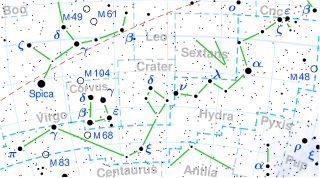
KNOWPIA
WELCOME TO KNOWPIA
Summary
λ Hydrae, Latinised as Lambda Hydrae, is a spectroscopic binary[12] star in the constellation Hydra. Its apparent magnitude is 3.61 Located around 33.3 parsecs (109 ly) distant. The spiral galaxy NGC 3145 is only 7.8′ away to the southwest.
| Observation data Epoch J2000 Equinox J2000 | |
|---|---|
| Constellation | Hydra |
| Right ascension | 10h 10m 35.27667s[1] |
| Declination | −12° 21′ 14.6938″[1] |
| Apparent magnitude (V) | 3.61[2] |
| Characteristics | |
| Spectral type | K0IIIbCN0.5[3] |
| U−B color index | 0.92[4] |
| B−V color index | 1.00[4] |
| Astrometry | |
| Radial velocity (Rv) | 19.4[5] km/s |
| Proper motion (μ) | RA: -201.27[1] mas/yr Dec.: -99.63[1] mas/yr |
| Parallax (π) | 30.0232 ± 0.6973 mas[6] |
| Distance | 109 ± 3 ly (33.3 ± 0.8 pc) |
| Absolute magnitude (MV) | +0.92[7] |
| Orbit[8] | |
| Period (P) | 1585.8 days |
| Semi-major axis (a) | 16.79 mas |
| Eccentricity (e) | 0.138 |
| Inclination (i) | 79.49° |
| Longitude of the node (Ω) | 249.62° |
| Periastron epoch (T) | 2448664.3906 |
| Argument of periastron (ω) (secondary) | 238.9° |
| Details | |
| λ Hya A | |
| Mass | 1-2[9] M☉ |
| Radius | 9.7[9] R☉ |
| Luminosity | 39.8[9] L☉ |
| Surface gravity (log g) | 2.64[9] cgs |
| Temperature | 4,656[9] K |
| Metallicity [Fe/H] | +0.25[10] dex |
| Rotational velocity (v sin i) | 1.9[11] km/s |
| Other designations | |
| Database references | |
| SIMBAD | data |
The primary is an orange giant of spectral type K0IIICN+1,[13] a star that has used up its core hydrogen, left the main sequence, and expanded into a giant. It is considered to be a red clump giant, a cool horizontal branch star that is burning helium in its core.[14]
λ Hydrae has two visual companions, components B and C, 11th and 13th magnitude stars respectively 71″ and 111″ away.[15]
References edit
- ^ a b c d van Leeuwen, F. (November 2007). "Validation of the new Hipparcos reduction". Astronomy and Astrophysics. 474 (2): 653–664. arXiv:0708.1752. Bibcode:2007A&A...474..653V. doi:10.1051/0004-6361:20078357. S2CID 18759600.
- ^ Ducati, J. R. (2002). "VizieR Online Data Catalog: Catalogue of Stellar Photometry in Johnson's 11-color system". CDS/ADC Collection of Electronic Catalogues. 2237: 0. Bibcode:2002yCat.2237....0D.
- ^ Keenan, Philip C.; McNeil, Raymond C. (1989). "The Perkins Catalog of Revised MK Types for the Cooler Stars". The Astrophysical Journal Supplement Series. 71: 245. Bibcode:1989ApJS...71..245K. doi:10.1086/191373.
- ^ a b Jennens, P. A. (1975). "A new photometric metal abundance and luminosity calibration for field G and K giants". Monthly Notices of the Royal Astronomical Society. 172 (3): 667–679. Bibcode:1975MNRAS.172..667J. doi:10.1093/mnras/172.3.667.
- ^ Wilson, Ralph Elmer (1953). "General catalogue of stellar radial velocities". Carnegie Institute Washington D.C. Publication: 0. Bibcode:1953GCRV..C......0W.
- ^ Brown, A. G. A.; et al. (Gaia collaboration) (August 2018). "Gaia Data Release 2: Summary of the contents and survey properties". Astronomy & Astrophysics. 616. A1. arXiv:1804.09365. Bibcode:2018A&A...616A...1G. doi:10.1051/0004-6361/201833051. Gaia DR2 record for this source at VizieR.
- ^ Anderson, E.; Francis, Ch. (2012), "XHIP: An extended hipparcos compilation", Astronomy Letters, 38 (5): 331, arXiv:1108.4971, Bibcode:2012AstL...38..331A, doi:10.1134/S1063773712050015, S2CID 119257644.
- ^ ESA (1997). "The Hipparcos and Tycho Catalogues". VizieR On-line Data Catalog. Bibcode:1997yCat.1239....0E.
- ^ a b c d e Cruzalèbes, P.; Rabbia, Y.; Jorissen, A.; Spang, A.; Sacuto, S.; Pasquato, E.; Chiavassa, A.; Chesneau, O.; Fréville, P. (2013). "SPIDAST: A new modular software to process spectrointerferometric measurements". Monthly Notices of the Royal Astronomical Society. 432 (2): 1658. arXiv:1304.1666. Bibcode:2013MNRAS.432.1658C. doi:10.1093/mnras/stt593.
- ^ Hinkel, Natalie R.; Timmes, F. X.; Young, Patrick A.; Pagano, Michael D.; Turnbull, Margaret C. (2014). "Stellar Abundances in the Solar Neighborhood: The Hypatia Catalog". The Astronomical Journal. 148 (3): 54. arXiv:1405.6719. Bibcode:2014AJ....148...54H. doi:10.1088/0004-6256/148/3/54. S2CID 119221402.
- ^ De Medeiros, J. R.; Da Silva, J. R. P.; Maia, M. R. G. (2002). "The Rotation of Binary Systems with Evolved Components". The Astrophysical Journal. 578 (2): 943–950. arXiv:astro-ph/0207288. Bibcode:2002ApJ...578..943D. doi:10.1086/342613.
- ^ Eggleton, P. P.; Tokovinin, A. A. (September 2008). "A catalogue of multiplicity among bright stellar systems". Monthly Notices of the Royal Astronomical Society. 389 (2): 869–879. arXiv:0806.2878. Bibcode:2008MNRAS.389..869E. doi:10.1111/j.1365-2966.2008.13596.x. S2CID 14878976.
- ^ Gray, R. O.; et al. (July 2006). "Contributions to the Nearby Stars (NStars) Project: spectroscopy of stars earlier than M0 within 40 pc-The Southern Sample". The Astronomical Journal. 132 (1): 161–170. arXiv:astro-ph/0603770. Bibcode:2006AJ....132..161G. doi:10.1086/504637. S2CID 119476992.
- ^ Alves, David R. (2000). "K-Band Calibration of the Red Clump Luminosity". The Astrophysical Journal. 539 (2): 732–741. arXiv:astro-ph/0003329. Bibcode:2000ApJ...539..732A. doi:10.1086/309278.
- ^ Mason, Brian D.; Wycoff, Gary L.; Hartkopf, William I.; Douglass, Geoffrey G.; Worley, Charles E. (2001). "The 2001 US Naval Observatory Double Star CD-ROM. I. The Washington Double Star Catalog". The Astronomical Journal. 122 (6): 3466. Bibcode:2001AJ....122.3466M. doi:10.1086/323920.



